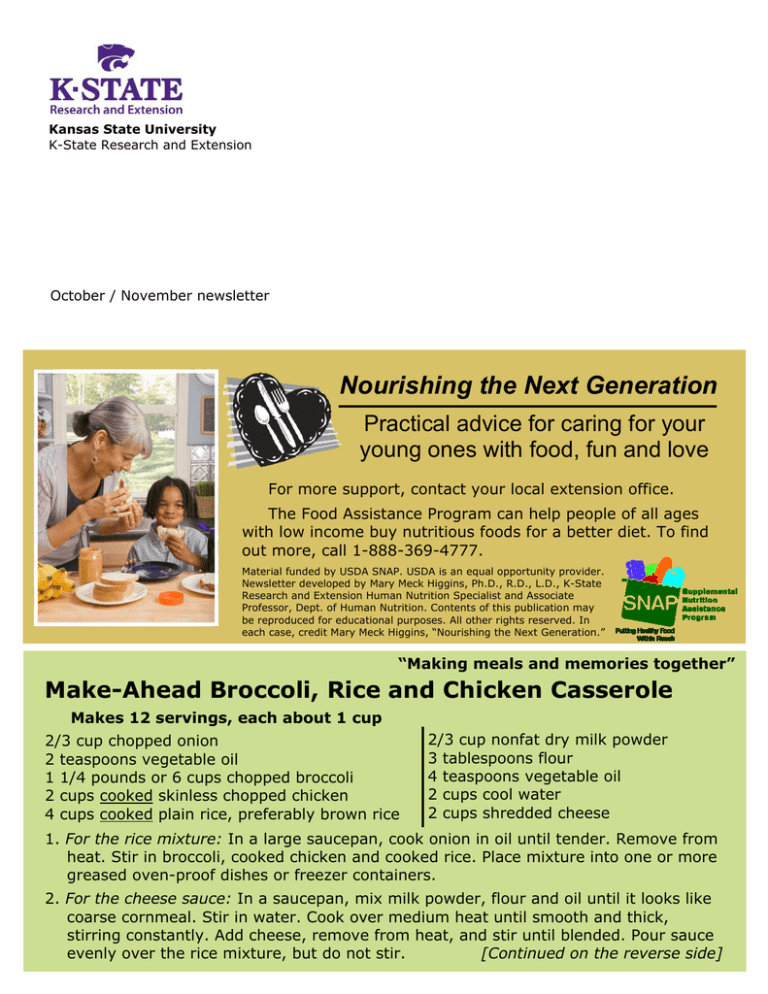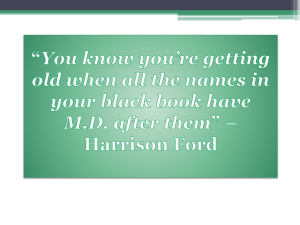Nourishing the Next Generation Practical advice for caring for your
advertisement

Kansas State University K-State Research and Extension October / November newsletter Nourishing the Next Generation Practical advice for caring for your young ones with food, fun and love For more support, contact your local extension office. The Food Assistance Program can help people of all ages with low income buy nutritious foods for a better diet. To find out more, call 1-888-369-4777. Material funded by USDA SNAP. USDA is an equal opportunity provider. Newsletter developed by Mary Meck Higgins, Ph.D., R.D., L.D., K-State Research and Extension Human Nutrition Specialist and Associate Professor, Dept. of Human Nutrition. Contents of this publication may be reproduced for educational purposes. All other rights reserved. In each case, credit Mary Meck Higgins, “Nourishing the Next Generation.” “Making meals and memories together” Make-Ahead Broccoli, Rice and Chicken Casserole Makes 12 servings, each about 1 cup 2/3 cup chopped onion 2 teaspoons vegetable oil 1 1/4 pounds or 6 cups chopped broccoli 2 cups cooked skinless chopped chicken 4 cups cooked plain rice, preferably brown rice 2/3 cup nonfat dry milk powder 3 tablespoons flour 4 teaspoons vegetable oil 2 cups cool water 2 cups shredded cheese 1. For the rice mixture: In a large saucepan, cook onion in oil until tender. Remove from heat. Stir in broccoli, cooked chicken and cooked rice. Place mixture into one or more greased oven-proof dishes or freezer containers. 2. For the cheese sauce: In a saucepan, mix milk powder, flour and oil until it looks like coarse cornmeal. Stir in water. Cook over medium heat until smooth and thick, stirring constantly. Add cheese, remove from heat, and stir until blended. Pour sauce evenly over the rice mixture, but do not stir. [Continued on the reverse side] Nourishing the Next Generation Practical advice for caring for your young ones with food, fun and love Do-It-Yourself Frozen Dinners Frozen dinners can be a convenient alternative to a homemade meal on busy days when there isn’t much time to cook. But processed frozen dinners from the grocery store can be expensive and are usually high in sodium. Is there a better alternative? Yes! Prepare homemade frozen dinners. Isn’t this difficult? No way! When you are preparing a main dish, it takes only a little more effort and time to make enough for several meals. You can either freeze all of the prepared food in mealsized packages, or you can serve part of the food immediately and freeze the rest for later use. Read on to learn tips for making homemade frozen meals at your home. · Some food ingredients do not freeze well, including: mayonnaise, yogurt, cream puddings, custard, gelatin, eggs, unbaked biscuits, and fruits and veggies with a high water content, such as cooked potatoes, cucumbers, lettuce, citrus and watermelon. · Cool foods quickly and freeze them promptly. Place shallow containers of hot food in a larger pan filled with ice or ice water, and stir it often to help cool the food faster. · Use freezer containers with wide openings, so that food can be removed without thawing it first. Pack foods tightly into freezer containers to reduce the amount of air in the package. Allow room in the package for the food to expand as it freezes. · Label all packages with the food’s name, date prepared, and baking instructions, if any. Keep a list of the foods you freeze and plan to eat them within one or two months. · Avoid overloading your freezer compartment. Foods should freeze solidly in 24 hours. Make-Ahead Broccoli, Rice and Chicken Casserole Recipe preparation directions, continued from the reverse side: 3. Go to step 4 now or, to freeze it: Cover containers with tight-fitting lids or with foil or freezer wrap. Label with the name of the item, date prepared, and baking instructions. Freeze. Before use, thaw in a refrigerator. 4. Bake in an oven-proof dish, covered, at 350 degrees F. for 45-50 minutes, or until hot. Cover and refrigerate any leftovers within two hours. Nutrition Facts per 1/12th of recipe, about a 1-cup serving: 250 calories, 10g fat, 4.5g saturated fat, 0g trans fat, 40mg cholesterol, 170mg sodium, 23g carbohydrate, 3g dietary fiber and 16g protein. Daily Values: 10% vitamin A, 70% vitamin C, 20% calcium, 6% iron. No added sugars. Kansas State University Agricultural Experiment Station and Cooperative Extension Service, Manhattan, KS. K-State Research and Extension is an equal opportunity provider and employer. Kansas State University, County Extension Councils, Extension Districts and the U.S. Department of Agriculture Cooperating.




